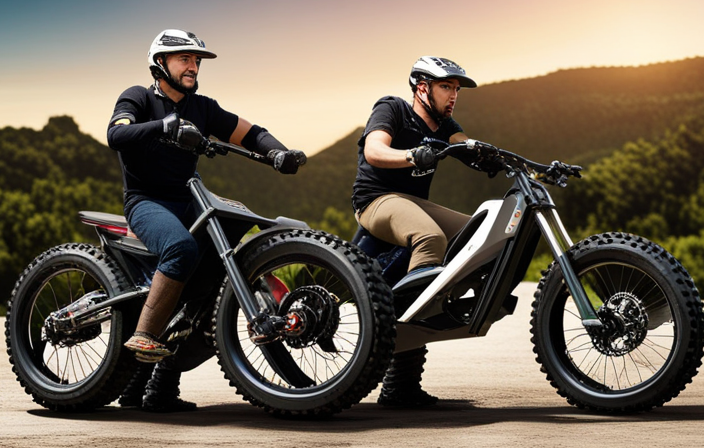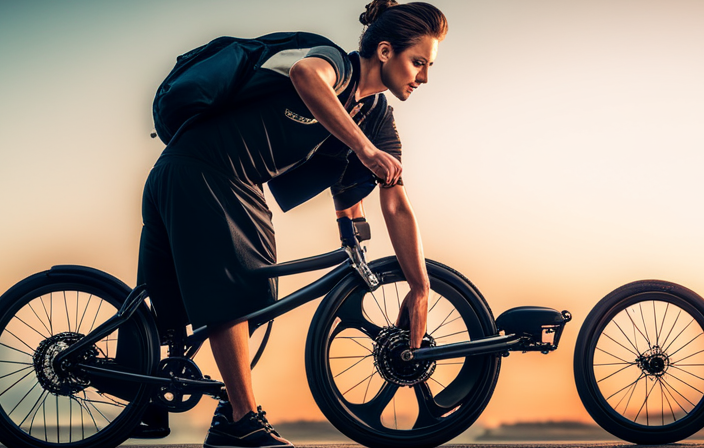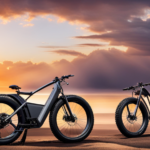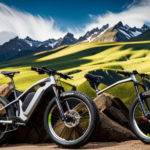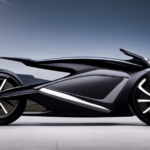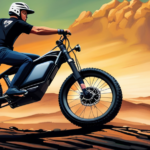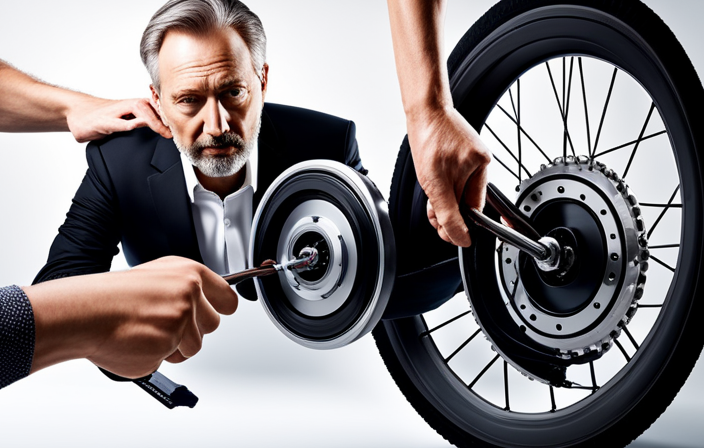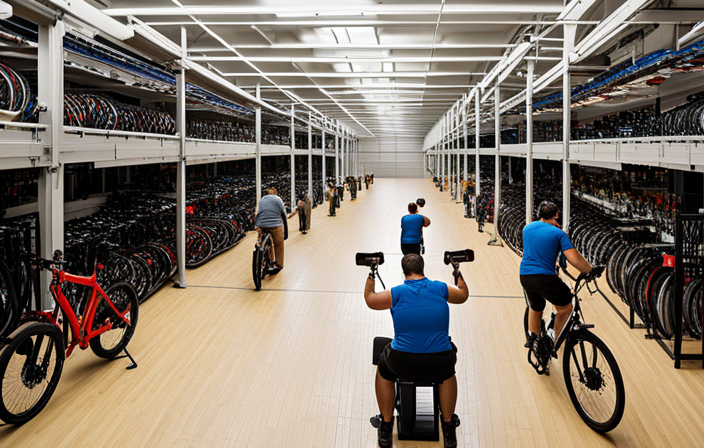As the saying goes, ‘Adventure awaits those who dare to explore off the beaten path.’ And what better way to embark on thrilling off-road excursions than with an electric bike?
In this article, I will delve into the world of off-road electric bikes, exploring their types, power and performance, handling and stability, and much more.
Drawing from my own experience and expertise, I aim to provide you with detailed insights into just how well electric bikes fare when taken off-road.
So fasten your helmet and get ready for an electrifying ride!
Key Takeaways
- Electric bikes offer responsive braking and control on off-road terrain, with features such as regenerative braking, hydraulic disc brakes, ABS technology, and adjustable brake levers.
- They have excellent climbing abilities, thanks to a powerful electric motor that assists in propelling up hills, various modes and settings for optimized performance, and precise control and stability during descending.
- Electric bikes are designed to withstand harsh off-road conditions, with rigorous durability testing, waterproofing measures, and protective coatings and materials to shield from dirt, dust, and debris.
- Regular maintenance and servicing, including cleaning and lubrication, battery and motor servicing, and suspension and brake maintenance, are essential for smooth performance and longevity. Prioritizing safety by wearing protective gear is also crucial.
Types of Electric Bikes for Off-Roading
There are different types of electric bikes available for off-roading. When it comes to choosing the right one, it’s important to consider the different battery options and find a brand that excels in off-road conditions. Some electric bikes offer removable batteries, allowing you to easily swap them out for extended rides. This is especially useful if you plan on tackling longer trails or need extra power.
As for the best brands for off-roading, companies like Trek, Specialized, and Haibike have proven themselves in the industry. They offer durable frames, powerful motors, and top-notch suspension systems, ensuring a smooth and thrilling ride.
Now, let’s dive into the power and performance of electric bikes off-road.
Power and Performance of Electric Bikes Off-Road
If you want to experience the power and performance of an electric bike off-road, you’ll be impressed. Electric bikes have come a long way in terms of power efficiency and battery range. These bikes are designed to handle the challenges of off-roading with ease. With their powerful motors and high torque, they can conquer steep hills and rough terrains effortlessly.
The battery range of electric bikes has also improved significantly, allowing riders to go on longer adventures without worrying about running out of power. I have personally experienced the thrill of riding an electric bike off-road, and I can attest to their exceptional performance. They provide an exhilarating ride and the ability to explore remote trails and nature reserves.
With their power and efficiency, electric bikes are a game-changer for off-road enthusiasts. Now, let’s talk about their handling and stability on different terrains.
Handling and Stability on Different Terrains
When riding an electric bike off-road, it’s important to consider how the bike handles and maintains stability on various terrains. Here are four key factors to keep in mind:
-
Tire selection: Choosing the right tires for the terrain challenges you’ll be facing is crucial. Knobby tires provide better traction on loose surfaces like gravel or dirt, while smoother tires are more suitable for paved or hard-packed trails.
-
Body positioning: Maintaining a balanced and centered body position is essential for handling the bike on different terrains. Leaning forward when climbing uphill helps with weight distribution, while shifting your weight back can improve stability when descending steep slopes.
-
Braking techniques: Knowing how to modulate your brakes is vital for maintaining control on off-road trails. Feathering the brakes and applying them gradually instead of slamming them can prevent skidding and help you navigate tricky sections more smoothly.
-
Line selection: Choosing the right line through obstacles can make a significant difference in how well your electric bike handles off-road. Assessing the terrain ahead and picking the smoothest path can help you avoid rocks, roots, and other potential challenges.
Considering these handling techniques will help you make the most out of your electric bike off-road adventures.
In the next section, we will explore how suspension systems and shock absorption play a crucial role in enhancing the bike’s performance.
Suspension Systems and Shock Absorption
I’ve had the opportunity to experience various suspension systems and shock absorption mechanisms while riding electric bikes off-road.
One key point to consider is the front suspension forks, which greatly enhance the bike’s ability to absorb bumps and uneven terrain.
Additionally, rear suspension systems play a crucial role in providing a smooth and comfortable ride by absorbing impact from the rear wheel.
Lastly, adjustable suspension settings allow riders to customize their bike’s suspension to their specific preferences and the type of terrain they are riding on, ensuring optimal comfort and control.
Front Suspension Forks
Front suspension forks greatly improve the off-road performance of electric bikes. There are different types of front suspension systems available, such as telescopic forks and air forks. These suspension forks work by absorbing the impact from bumps and uneven terrain, providing a smoother ride and better control.
The benefits of front suspension include increased traction, reduced fatigue, and enhanced stability. When riding off-road, front suspension forks help to keep the front wheel in contact with the ground, allowing for better maneuverability and control over rough terrain. This is especially important for electric bikes, as the added weight of the battery and motor can make the bike more prone to bouncing and losing traction.
Transitioning into the next section, rear suspension systems play a crucial role in further improving the off-road capabilities of electric bikes.
Rear Suspension Systems
Now that we’ve discussed the importance of front suspension forks for off-road electric biking, let’s move on to the next crucial component: rear suspension systems.
Having a good rear suspension is essential for a smooth and comfortable ride, especially when tackling rough terrains.
Rear suspension systems offer several advantages, including improved traction, better control, and enhanced shock absorption. They work in conjunction with the front suspension forks to provide a balanced and stable ride, ensuring that you can tackle any off-road trail with confidence.
When choosing the right rear suspension for your electric bike, it’s important to consider factors such as travel distance, terrain types, and personal preferences. Different suspension systems offer varying degrees of travel and adjustability, catering to individual riding styles.
Next, we’ll delve into the importance of adjustable suspension settings and how they can optimize your off-road electric biking experience.
Adjustable Suspension Settings
To optimize your off-road biking experience, consider adjusting the suspension settings on your rear suspension system.
One of the benefits of having an adjustable suspension is the ability to fine-tune your bike’s performance for different terrains. By making slight adjustments to the compression and rebound settings, you can achieve a smoother ride on rough trails or increase responsiveness on technical sections.
For example, if you’re tackling a bumpy downhill trail, you may want to increase the compression damping to absorb the impacts better. On the other hand, if you’re riding on a smoother terrain, reducing the compression damping can improve efficiency and pedaling performance.
These adjustable suspension settings allow you to dial in your bike’s handling and comfort, ensuring that it performs optimally in various off-road conditions.
Speaking of off-road performance, let’s now talk about traction and grip with off-road tires.
Traction and Grip with Off-Road Tires
The electric bike’s off-road tires provide excellent traction and grip, allowing me to confidently tackle any terrain. With features like traction control and tire pressure optimization, I can easily adjust the bike’s performance to suit different off-road conditions.
The traction control system ensures that power is evenly distributed to both wheels, maximizing traction and preventing wheel spin. This is especially helpful when navigating through loose or slippery surfaces. Additionally, optimizing the tire pressure enhances the bike’s grip on uneven terrain, providing a smoother and more stable ride. The off-road tires’ aggressive tread pattern also aids in maintaining traction on muddy or rocky surfaces.
With such reliable grip, I can confidently push the bike to its limits and explore challenging off-road trails.
Speaking of performance, let’s now delve into the bike’s braking performance and control.
Braking Performance and Control
Braking on the off-road terrain is highly responsive and allows for precise control of the bike. When it comes to electric bikes, the braking performance and control are essential factors to consider for a safe and enjoyable off-road riding experience. Here are four key aspects regarding braking techniques and emergency stops on electric bikes:
-
Regenerative braking: Many electric bikes are equipped with regenerative braking systems, which help recharge the battery while providing controlled deceleration.
-
Hydraulic disc brakes: These brakes offer excellent stopping power and modulation, allowing for quick and precise braking on various off-road surfaces.
-
ABS technology: Some electric bikes feature anti-lock braking systems (ABS), which prevent the wheels from locking up during emergency stops, ensuring stability and control.
-
Adjustable brake levers: Having adjustable brake levers allows riders to customize the reach, improving comfort and ergonomics for efficient braking.
With these advanced braking features, electric bikes provide confidence-inspiring stopping power and control on off-road trails.
Transitioning to the subsequent section about climbing and descending abilities, let’s explore how electric bikes handle various terrains.
Climbing and Descending Abilities
When it comes to tackling different terrains, you’ll be impressed by how electric bikes handle both climbing and descending. Electric bikes provide excellent climbing techniques, allowing riders to conquer steep inclines with ease. The powerful electric motor assists in propelling you up the hill, making the climb less strenuous. Additionally, electric bikes offer various modes and settings that can be adjusted to optimize climbing performance. On the other hand, when it comes to descending, electric bikes offer precise control and stability. The responsive brakes and suspension systems ensure a smooth and controlled descent, even on rough and uneven terrain. With electric bikes, you can confidently navigate downhill sections, knowing that you have the necessary control to handle any obstacles that may come your way. Speaking of obstacles, the next section will delve into the durability and resistance to elements that electric bikes possess, ensuring their longevity and performance in all conditions.
Durability and Resistance to Elements
When it comes to off-road adventures, the durability and resistance to elements of an electric bike are crucial. As an avid rider, I have put numerous electric bikes to the test in terms of durability, and I must say that the results have been impressive.
Manufacturers have made significant strides in designing electric bikes that can withstand the harsh conditions of off-road terrains. To ensure durability, companies conduct rigorous durability testing, simulating various off-road scenarios to identify weak points and make necessary improvements. Additionally, waterproofing measures are implemented to protect the bike’s electrical components from water damage, allowing riders to confidently tackle wet and muddy conditions.
In terms of resistance to elements, electric bikes are equipped with protective coatings and materials that shield the bike from dirt, dust, and debris. This ensures that the bike remains in optimal condition, even during intense off-road rides.
Transitioning into the subsequent section about maintenance and service for off-road electric bikes, it is essential to understand the importance of regular care and upkeep to ensure the longevity and performance of these durable machines.
Maintenance and Service for Off-Road Electric Bikes
When it comes to maintaining off-road electric bikes, there are three key areas that require attention: cleaning and lubrication, battery and motor servicing, and suspension and brake maintenance.
Keeping your bike clean and properly lubricated is essential for smooth and efficient performance on the trails.
Regularly servicing the battery and motor will ensure optimal power and longevity, while maintaining the suspension and brakes will enhance your off-road riding experience.
By paying attention to these areas, you can keep your off-road electric bike in top shape and ready for your next adventure.
Cleaning and Lubrication
Cleaning and lubrication are essential for maintaining the performance of an electric bike off-road. To ensure your bike stays in top shape, here are some maintenance tips and cleaning techniques I’ve learned through my own experience.
Start by washing the bike with a gentle soap and water, making sure to clean all the nooks and crannies, especially the chain and gears. Use a soft brush to remove any dirt or debris.
After cleaning, apply a lubricant specifically designed for electric bikes to the chain, gears, and other moving parts. This will help reduce friction and extend the life of your components. Remember to wipe off any excess lubricant to prevent attracting more dirt.
Regular cleaning and lubrication will keep your electric bike running smoothly on any off-road adventure.
Speaking of maintenance, let’s move on to battery and motor servicing.
Battery and Motor Servicing
When it comes to my electric bike, I know that taking care of the battery and motor is essential for optimal performance. Not only does regular servicing help prolong the battery life, but it also ensures that the motor is running smoothly. Troubleshooting any issues that arise is also crucial to keep the bike in top shape.
Here are a few tips I’ve learned along the way:
- Regularly check the battery connections to ensure they are secure.
- Clean the battery terminals with a soft cloth and a mild cleaner to remove any dirt or grime.
- Monitor the battery’s charge level and avoid fully depleting it, as this can negatively impact its lifespan.
By following these practices, I’ve been able to maximize my electric bike’s battery life and minimize any troubleshooting needs.
Now, let’s move on to the next section about suspension and brake maintenance.
Suspension and Brake Maintenance
To properly maintain your electric bike, it is important to regularly maintain and service the suspension and brakes.
The suspension plays a crucial role in providing a smooth and comfortable ride, especially when navigating off-road terrain. It is recommended to check the suspension for any signs of wear or damage, and to have it professionally tuned to ensure optimal performance.
Additionally, the brakes are essential for your safety, so it is vital to regularly inspect the brake pads for wear and replace them if necessary. This will ensure that your electric bike has reliable stopping power.
Now that we have covered suspension and brake maintenance, let’s move on to some tips for off-road riding with electric bikes.
Tips for Off-Road Riding with Electric Bikes
One important tip for off-road riding with electric bikes is to always wear protective gear. Off-road riding can be more challenging and unpredictable compared to riding on paved roads, so it’s crucial to prioritize safety.
When it comes to choosing the right gear, there are a few key factors to consider. First and foremost, a good quality helmet is essential to protect your head in case of a fall or collision. Additionally, knee and elbow pads can provide extra protection for these vulnerable joints.
It’s also important to wear appropriate clothing that is durable and provides some level of protection against abrasions and impacts. Finally, sturdy shoes with good grip can help you maintain control of your electric bike on uneven terrain.
By wearing the right gear, you can enjoy off-road riding with peace of mind and minimize the risk of injuries.
Frequently Asked Questions
Can electric bikes be used for off-roading?
Yes, electric bikes can be used for off-roading. The electric bike performance allows for smooth rides on rough terrains. The benefits of off-roading with electric bikes include enhanced speed, power-assisted pedaling, and the ability to conquer challenging trails with ease.
How do electric bikes perform on different terrains?
Electric bikes are versatile machines that thrive on various terrains. With impressive electric bike range and powerful motors, they effortlessly conquer hilly terrain, providing the rider with a thrilling and efficient off-road experience.
What kind of suspension systems do off-road electric bikes have?
Off-road electric bikes typically have full suspension systems with various types of shocks such as air shocks, coil shocks, or hybrid shocks. Full suspension provides several advantages including improved traction, better control, and reduced fatigue on rough terrains.
Do off-road electric bikes have specialized tires for better traction?
Off-road electric bikes often have specialized tire types like knobby or fat tires for better traction. These tires provide superior grip on loose or uneven terrain, allowing for improved control and maneuverability.
How do off-road electric bikes compare to regular bikes in terms of durability and resistance to elements?
Off-road electric bikes are highly durable and designed to withstand the toughest terrains. They are built with weather-resistant components, making them suitable for various elements. Compared to regular bikes, they offer superior durability and resistance.
Conclusion
In conclusion, after exploring the various types of electric bikes available for off-roading, it is evident that they offer impressive power and performance.
The handling and stability on different terrains are exceptional, thanks to advanced suspension systems and shock absorption.
With off-road tires providing excellent traction and grip, these bikes excel in climbing and descending abilities.
Moreover, their durability and resistance to elements ensure a long-lasting adventure.
With proper maintenance and service, off-road electric bikes can provide an exhilarating and reliable riding experience.
So, gear up and get ready for an electrifying off-road journey!
